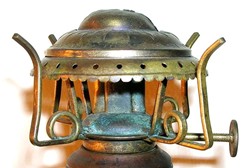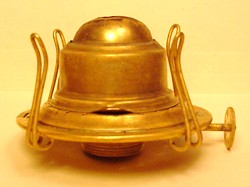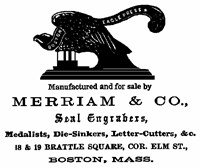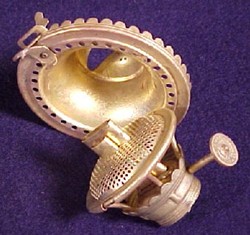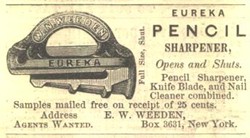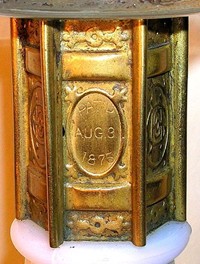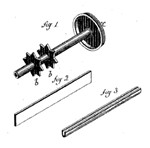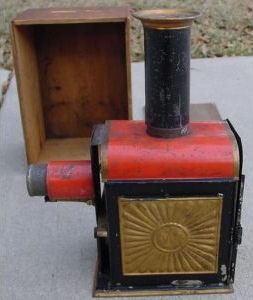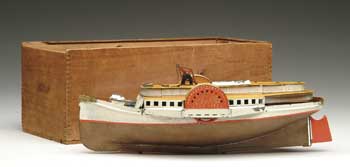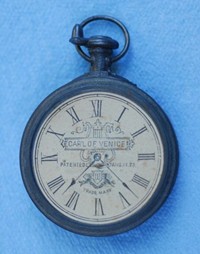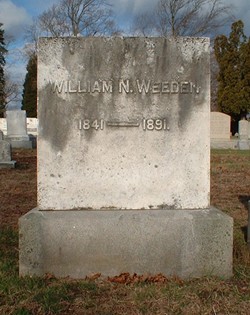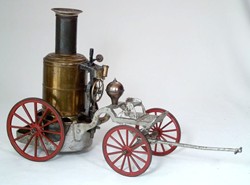William Nye Weeden was born in New Bedford, Massachusetts, on April 27, 1841.1 William was the third child of Daniel and Ruth Nye Weeden; he had two older siblings, James E. and Abbie E., and a younger brother, Robert H. 2 William was educated in the schools of New Bedford.3 He married Abbie H. Taber on June 25, 1863. They had three children: Mabel S., born in 1869, Florence T., born in 1872, and Walter L., born in 1875. William's father, Daniel, died when William was just four years of age.4 There is no evidence that his mother, Ruth, ever remarried. W.N. Weeden died on July 25, 1891 in Rangeley Lake, Maine, where "he had gone in the hope of restoring his health," presumably after a protracted illness.5
Weeden was granted more than forty patents over his lifetime. In English and American Tool Builders, Joseph W. Roe practically elevated Weeden to the levels of royalty among the early Naugatuck Valley brass men. He spoke of Weeden in the same vain as Hiram W. Hayden, Lewis J. Atwood and Leroy S. White, all prolific inventors and individuals whose "work contributed to the growth of the industry."7A Follow this link for a chronological listing of W.N. Weeden's patents. There is also a patent table below with an interface to the United States Patent and Trademark Office where you can view the patent documents. William started out as a jeweler, having learned the trade as an apprentice to New Bedford watchmaker, jeweler and engraver James Tucker Almy at his shop on Union Street.8 Almy's advertisement in the 1859 New Bedford City Directory listed him as a "Dealer in clocks, watches, jewelry and silverware....Also, engraver and copper plate printer." Around 1860, Weeden moved from New Bedford to Boston with his newly acquired skills and opened a small watch repairing shop. He also made stencils and dies.9 Weeden would live and work in Boston for about twelve years.10 His interests and training in the jewelery trade, particularly that of clocks and watches, would suit him well in his future ventures.
In the 1865 Boston City Directory, Weeden is listed as a partner (or principle) in the firm of Merriam & Company with John C. Merriam. They are seal and letter engravers in business at 18 and 19 Brattle Square. Merriam's business apparently dated back to the 1850's as a partnership with his brother, Joseph, who appears to be absent from the business at the time Weeden is there, and returns once he departs.11 One of Weeden's earliest patents for a hand stamp was with J.C. Merriam in 1866. Around 1868, Weeden apparently leaves Merriam and begins a collaboration with Edward A. Locke. Together, they obtain a number of patents in '68 and '69. In the 1868 Boston City Directory, Weeden's listing stated, "burner and lamp shade manufacturer," consistent with the patents granted at the time. By 1869 Weeden had started his own business at 50 Sudbury Street. His advertisement in the 1869 Boston City Directory reads "Wm. N. Weeden, (formerly of Merriam & Co.,) Fine Seal Engraving and Die Sinking, Steel Stamps and Letter Cutting, Designs, Models, and Patterns in Wax or Clay, Moulds for Britannia or Soft Metal." In the 1870 U.S. Census, Weeden listed his occupation as Letter Cutter. Soon thereafter Weeden had teamed up with Edward A. Locke at the Novelty Manufacturing Company located at 50 Sudbury Street as noted in the 1870 Boston City Directory. Locke was a successful entrepreneur and patent solicitor. Locke will turn up again shortly in the Waterbury watch business; he and Weeden would have a long-term relationship spanning fourteen years or more.
By the time the 1872 directory is compiled, Weeden had removed himself to Waterbury and is no longer listed. He has apparently sold his interest in the company to E.A. Locke. Locke and The Novelty Manufacturing Company continue on through the 1875 listing, but it appears that Locke has sold the firm to Robert Woodman & Company. Locke will soon be on his way to Waterbury.
While in Boston, William collaborated with Edward A. Locke on three of his early lighting inventions: US Patent numbers 73,538 for an improvement in kerosene lamps; 81,915 for an improvement in over-the-chimney shade holders; and 84,286 for an improved mode of packing paper lamp shades. Locke was a seemingly interesting character and likely took advantage of every opportunity to turn a dollar. He has at least nine patents relating to innovations for tagging or labeling commodities. Weeden's patent number 77,424 granted in 1868 for improvement in tags for marking cotton bales is an improvement on E.A. Locke's earlier patent number 42,860. In 1869 Weeden obtained patent number 92,850 for a paper collar box with Locke and number 96,748 for a pencil sharpener, assigned to George Merritt of New York City. W.N. Weeden moved to Waterbury and took a position with The Benedict & Burnham Manufacturing Company on January 1, 1872.12 From 1872 until 1878, Weeden was Superintendent of The City Manufacturing Company.
During his tenure with Benedict & Burnham, Weeden obtained thirteen patents for lamp burners and trimmings; eleven of them in his own name and two in collaboration with James G. Hallas. All of these patents were assigned to Benedict & Burnham and ranged over a period of roughly six years between October 1872 and November 1878 -
Edward A. Locke was granted one patent on May 7, 1878 for a shade holder for gas lamps, number 203,471, also assigned to Benedict & Burnham. Weeden's most recognizable burner is the RADIANT, pictured at the top of the page. Around the outer edge of the deflector is embossed: 'RADIANT' PATENTED OCT. 1.-72. BENEDICT & BURNHAM MANUF'G CO. The thumb wheel is marked: PAT'D DEC. 10-67 & OCT 1-72 / B&B. M'FG CO. The 1872 dates refer to two patents obtained by Weeden on that day - nos. 131,917 & 131,818. The 1867 date is for the Baldwin vapor vent which is used on the burner. The thumb wheel on another version of this burner bears the add'l dates of Nov. 10, 1868 (Moore's 83,874) & Feb. 18, 1873 (Weeden's 136,113). On August 31, 1875 Weeden obtained a patent for a lamp connector. In the author's opinion, this is one of the most beautiful connectors made. It bears the patent date, PAT'D / AUG. 31 / 1875, as shown in the image.
Sometime around 1878, Weeden was tapped to head up the watch making division. The listing in the 1880 U.S. Census states his occupation as Sup't Watch Shop. The success of his efforts, which led to the formation of The Waterbury Watch Company, "was doubtless due in large part to Mr. Weeden's ability, ingenuity and energy, coupled with Charles Benedict's faith in his judgment.
By the summer of 1882, William left the employ of Benedict & Burnham and returned to New Bedford.16 Weeden established himself in business in Grinnell's foundry and set forth to manufacture "novelties in metal." To this end, he often made his own tooling for the items he manufactured - presses, dies, molds and other production items.17 Weeden realized the value and the uniqueness of these specialty tools, patterns and dies and they were locked away in a fire-proof safe at the close of business each day.18 As his business expanded, he outgrew his current location and sought more suitable accommodations. He leased one-third of the upper floor of a brick building located and Nos. 112 and 114 North Water Street. Rapid expansion ensued and before long he occupied the entire building.19 In the 1883 New Bedford City Directory, Weeden took out a half-page ad for his business. It noted that the office and manufacturing department was located in the New Bedford Foundry Building on the corner of Coffin and Water streets, and the Paint and Finishing department was at the North Water Street address, and they had telephones in both departments! His entry in the business directory is The Novelty Metal Works, a name he apparently resurrected from his earlier venture in Boston. Without further research, it is uncertain exactly when he renamed the company The Weeden Manufacturing Company, but it appears that it was within the next year. He's also listed under "Match Safe Manf'g." which must have formed the basis for the company during the formative years.
By 1883, The Weeden Manufacturing Company was in full swing. In 1884 he invented a toy steam engine and filed a patent application for it on September 3, 1884. The patent would be granted on May 19, 1885, U.S. Patent Number 318,335. which formed the basis for a very successful business. The toy steam engine depicted in the margin above is Weeden's #1 Upright Steam Engine.
On August 14, 1883, Weeden was granted patent number 283,307 for a music box. The article is in the shape of a pocket watch. (Gee, I wonder where he got that idea!?) The face of the watch, made of paper, bears a banner comprised of a lyre and the title of the tune the music box plays, the Weeden trademark and the patent date. The music box plays a "clanky" tune like the old jack-in-the-box toys you probably had as a kid. An advertisement from A.E. Pratt & Company of New York in the February 16, 1884 issue of Scientific American reads: "...the greatest novelty ever offered to the boys and girls of America...with music box attachment concealed within, so arranged that when wound at the stem, plays one of the following tunes: Home, Sweet Home, Yankee Doodle, Blue Bells of Scotland, Coming Through the Bye, Swanee River, Carnival of Venice, Grandfather's Clock, Waltz, Polka, Schottische, and Wait Till the Clouds Roll By. They were 36 cents each, or four for $1.00 if ordered before April 1st! The Weeden Manufacturing Company manufactured a number of clockwork-driven mechanical banks in the late 1800's. Among these were the Plantation Savings Bank (shown in the left-hand margin above), Ding Dong Bell, and The Japanese Ball Tosser. All of these banks incorporated Weeden's five patents obtained on August 7, 1888 for elements relating to the clockwork mechanism. F.H. Griffith wrote many articles about Weeden's banks for Hobbies Magazine in the 1960's. At that time, few examples were known. Certainly with the advent of the Internet, more examples have surfaced, but they are still quite rare. At the Bill Bertoia Auction house in Philadelphia in July, 1998, selling The Stanley Sax Bank Collection, a Ding Dong Bell bank realized $74,000!22
In July, 1887, Weeden formed a stock company with a capital stock of $50,000. The officers were J. Arthur Beauvais, president; Charles E. Barney, treasurer; and William N. Weeden, superintendent.23 In 1889, after two years of hardship, the company was forced to restructure.24 Beauvais and other investors, convinced that the company was a worthwhile venture, reinvested sufficient capital to get the company back on it's feet.25 Shortly thereafter, the firm flourished. The business continued to prosper long after Weeden's death in 1891 and would become the most successful manufacturer of steam toys in the United States.26 William Ritchie, a former salesman for The Weeden Manufacturing Company who worked his way up through the ranks, took over as chief executive after Weeden's death.27 The company survived until the early 1950's when, as the allure of steam toys was replaced by other boyhood pursuits, the company's sales declined and it was sold. The buyer, with the intentions of restarting the venture, never did.28
William Nye Weeden and his wife Abbie are buried in the Rural Cemetery in New Bedford, Massachusetts. They are at rest in the southeast corner of Lot 85, Section A-3. Their graves are marked with austere white marble headstones. William died in Rangly [sic], Me. on July 25, 1891; he was only fifty years of age. His body was returned to New Bedford and he was interred there on July 31st. Abbie died at the age of 74 on Independence Day in 1917. Their daughter Florence and her infant son are also buried in the plot.29  The Patents of William N. Weeden The Patents of William N. Weeden
To view any of the above patents, enter the number in the box below and select Query USPTO Database. This will take you to the specific patent images on the U.S. Patent & Trademark Office Database. Learn more about the USPTO here. End Notes
Follow this link to review the End Notes. References
Follow this link to the List of References used to prepare this article. Acknowledgements
-- Bob Crider, Seal Press collector from Mexia, Texas; -- Art Gaier, Steam toy collector, Versailles, Ohio; -- Richard B. Hall, Restoration Consultant for American Buildings, New Bedford, Massachusetts; -- Bill Jones, Mechanical Bank Collectors of America; -- Richard Leach, Steam toy collector, Elkhart, Indiana; -- Arthur Motta, Jr., City of New Bedford Office of Tourism & Marketing; -- Laura Pereira, Assistant Librarian, Old Dartmouth Historical Society - New Bedford Whaling Museum; -- Frank Reichenbach, Toy train collector, Glastonbury, Connecticut; -- Jeff Smith, Friend and lamp collector; -- Kenneth Trobaugh, Steam toy collector, Front Royal, Virginia. Addendum
Author's note: I have purposely not gone into too much detail on the steam toys produced by William N. Weeden. Should the reader desire more information on the vast array of steam toys and accessories manufactured by The Weeden Manufacturing Company, there is a network of passionate collectors throughout the United States, and probably worldwide, who are willing to share their knowledge. There are also a number of catalog reprints available for collectors and Ken Trobaugh self-publishes a book which depicts all of the steam toy models produced. I can provide contact information for some of the generous folks who assisted me with my research. Contact me for more information.
| ||||||||||||||||||||||||||||||||||||||||||||||||||||||||||||||||||||||||||||||||||||||||||||||||||||||||||||||||||||||||||||
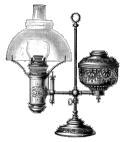
| Reference Desk | Lamp Information | Other Resources | On-Line Shopping |

Purveyors of Antique Lighting and Accessories
435 Main Street
 Hurleyville, New York 12747
Hurleyville, New York 12747
 Weeden Match Holder
Weeden Match HolderPat. no. 268,760 December 5, 1882 --------------------- Enlarge image [+] |
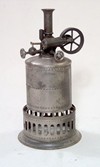 Weeden's No. 1
Weeden's No. 1Upright Steam Engine --------------------- Enlarge image [+] Photo: Art Gaier |
 Weeden's Plantation Savings Bank
Weeden's Plantation Savings BankAugust 7, 1888 --------------------- Enlarge image [+] Bank photo courtesy: Mechanical Bank Collectors of America |
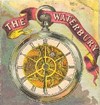 Trade Card for the
Trade Card for theWaterbury Watch --------------------- Enlarge image [+] |
artist, inventor and entrepreneur

William N. Weeden
^ Top of Page
Privacy Policy | Terms and Conditions of Use | Announcements
Copyright © 2001-2011 ~ Daniel Edminster | The Lampworks ~ All Rights Reserved
